

Despite digital technologies becoming an intrinsic part of today’s visual culture, a great interest in 19th century photographic technologies has found its way into the practices of contemporary photographers.[1] This retrospective turn to the analog can be viewed as a way to combat digital fatigue, a possibility to develop a more intimate relationship with the medium by working with one’s hands with a range of materials, a romance with the darkroom, a possibility to explore the medium beyond what the digital has to offer, and as an opportunity to slow down. I, however, see this turn as an important historical moment of self-organization by photographers and artists to create a space for themselves and, as it often turns out, create an operational model that can be self-sustaining. Most of these independent, self-organized spaces emerge in residential buildings, with a makeshift darkroom, and personal investment. The emergence of such spaces makes it possible to assert greater agency over the artistic processes, practice and outcomes, independent of the expectations of the mainstream spaces, resulting in explorations, experimentations, and process-driven work. The analog drive shouldn’t only be seen as a revivalist exercise, but also as a way to engage with the medium synchronous with the present times. This is a practice in making, and many photographers are organizing themselves around multitudes of such practices, often in dialog with each other, marked by the cultural, economic, and digital context within which photography exists today.
This essay is the outcome of interviews with three such initiatives in India – Studio Goppo started by Arpan Mukherjee and Shreya Mukherjee in Shantiniketan, 2015; Kānike by Indu Antony and Vivek Muthuramalingam in Bangalore, 2019; and the Maze Collective Studio run by Ashish Sahoo and Zahra Yazdani in Delhi, 2020. Tracing some of the commonalities and differences in themes that emerge in the narratives of these three spaces, this essay is an entry point to examine and contextualize the creation of sites outside the mainstream art / photo world as practice.
In the edited collection, Self Organised, Stine Hebert and Anne Szefer Karlsen talk about various terms that describe ways in which artists have organized themselves and their objection to terms that are binaristic in nature such as alternative, artist-run, or nonprofit. These terms situate self-organizing by artists against the institutions of the mainstream art world and its guiding principles. Anne Szefer Karlsen writes, “Our investigations have focused on self organisations beyond the limiting labels of ‘alternative’, non-profit’ or ‘artist-run’, which have been the prevailing terms dominating discussions of both the subject and its history in recent times. Looking at self-organisation as merely a response doesn’t take into consideration that the choice to be ‘self-organised’ implies a certain dualistic dependency, between the self – an individual – and an organised community within society. We see this dependency as being governed by common interest more than formality and obligation. The field of self-organisation is therefore more complex than the conventional separatist approach entails. It has moved beyond a process of simply dissolving boundaries between institutional and noninstitutional platforms to creating new possibilities.” Though, in this essay, I borrow the term self-organization from Hebert and Karlsen’s preface of the book, I also find resonance to Sarah Lowndes’s reading of the same paragraph in Learning to Get Along with People We Don’t Like, where she talks about DIY practices and refers to what is being called limited labels by Karlsen as “guiding principles of the recent history of do-it-yourself practices.” While I largely categorize institutions by artists as self-organizing, in the past, I have also described myself and practices around me as alternative, artist-led, and so on.[2] I am also interested in learning about how various institutions by artists describe themselves and enfold these chosen identities in the reading of different practices of self-organizing by artists. These identities are constantly evolving, and it would be a disservice to the institutions’ visions, positioning, struggles and emotional attachment to ways of describing themselves at the time of the interview. While all three institutions recognize themselves within the discourse of the critique of the white cube, their identity affiliations go beyond the common nomenclature reserved for such institutions and the thematic visions for the space become a way to self-identify.
Kānike for instance described themselves as a community arts center for their interest in connecting to the larger community which reflects extensively in their public programming, the architecture and the planning of spaces of the house that they inhabit, and in the personal practices of both Indu and Vivek.[3] Situated in the densely populated Cooke Town neighborhood of Bangalore, it lends the entire front room where most of the public programming takes place to sight as soon as the shutter of Kānike’s garage opens, making it hard to avoid the prying eyes of the neighbors and other passersby. By design and by choice, Kānike has become a community arts center at their new address in Cooke Town. This in contrast with their previous habitat, in a small, gated apartment block where their existence was only known to those connected to the art world, where the gates were guarded by men in uniform and their space not open to curious looks from the passer-by. The design and the location of their new home fits their vision of becoming a community art space. This identity is also befitting of their strong desire that Kānike not be called a photo studio, but instead a space where anything and everything is possible! Vivek’s passion and a desperate need to have access to a darkroom of his own, and Indu’s desire to have a darkroom and a bigger studio away from home brought them together, resulting in the space as it stands today as Kānike. While the space is managed and run by Indu and Vivek, Kānike, as a collective, has two more artists, Krishanu Chatterjee and Aparna Nori.
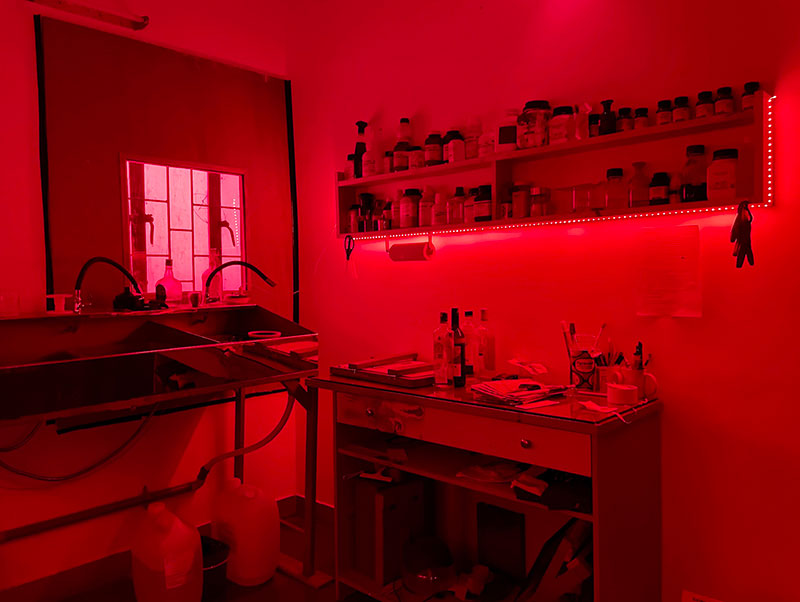
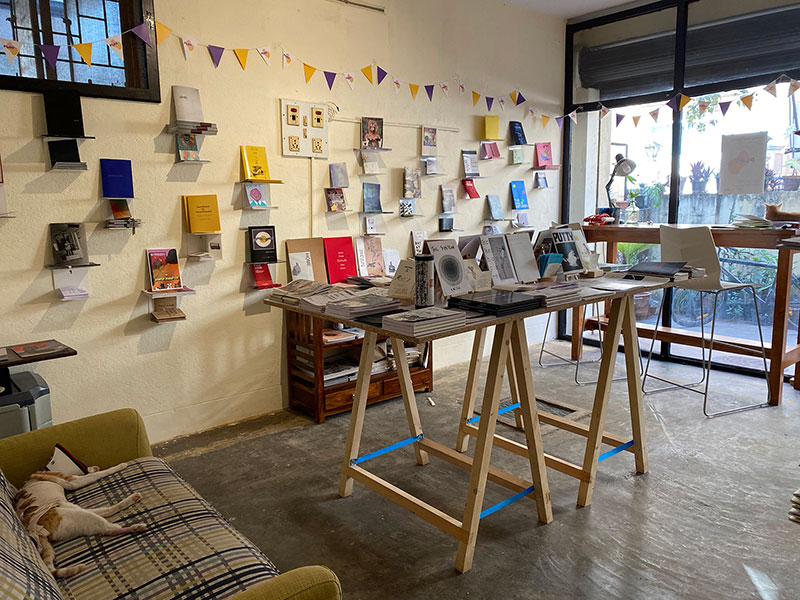 Photographs Courtesy of Kanike Studio
Photographs Courtesy of Kanike Studio
Studio Goppo is a studio space for storytellers. Goppo in Bengali means small stories and defines the purpose of the studio with their strong affiliation to research and practice of 19th century photography processes. Arpan’s interest in 19th century photography processes began in 2001 and went on to build a darkroom in 2004 – 2005. In 2008, they built a dedicated alternative photo studio at their residence. However, once, one of their very young children thought of the darkroom chemical as something attractive enough to be consumed. Fortunately, the parents were able to stop the children from acting upon their fantasies, only to realize they needed a space separate from their own home and away from the reach of their young and curious children. This led them to build a small studio next to their home, a separate space on the same premises – extending the home to accommodate their artistic practice and a range of interests both of Arpan and Shreya and many who cross paths with them. That year was 2014. Studio Goppo, as it stands currently, began with a workshop in 2015. Along with Arpan and Shreya running the studio, Manoj Biswas is a close friend of the studio, almost a third wheel in the functioning of Studio Goppo today.
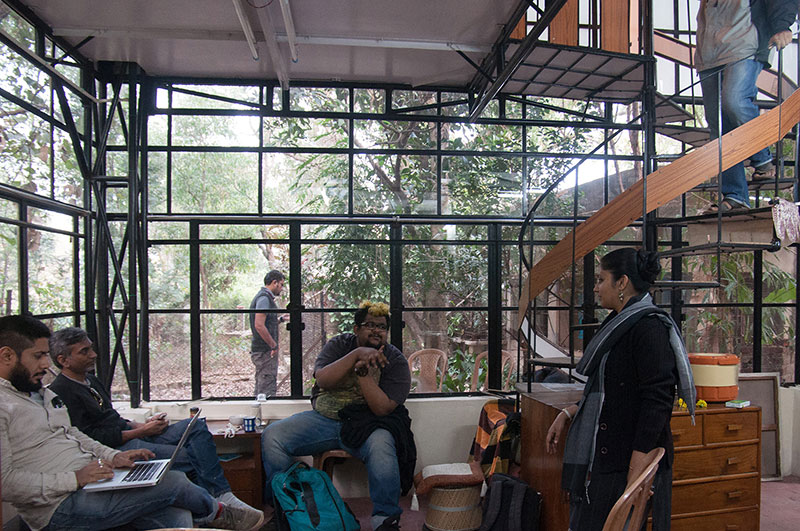
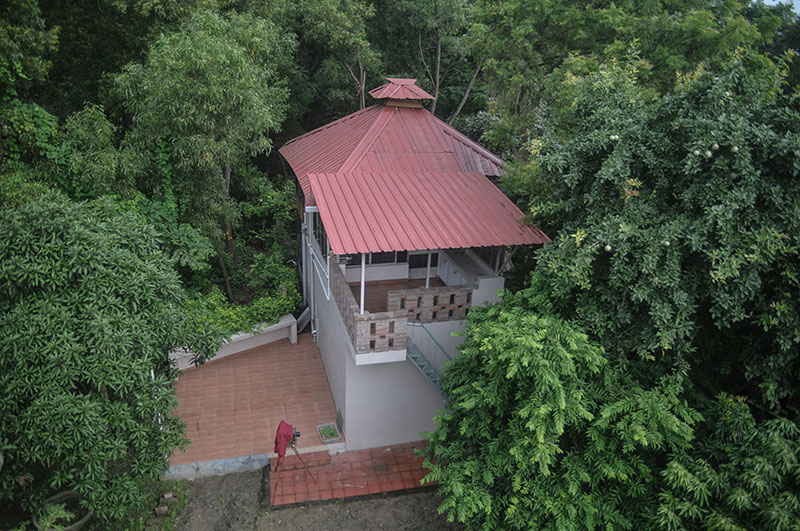 Photographs Courtesy of Studio Goppo
Photographs Courtesy of Studio Goppo
The Maze Collective Studio identifies itself as a collective, not because of the physical space they occupy but because of the coming together of the two individuals – Ashish and Zahra. Ashish, who has been working with 19th century photography processes for a very long time, had a separate flat above his own residence that he, along with a few of his friends, had converted into a darkroom and studio. This space was both public and private, shared between friends and often opened to the public for workshops and small events. Zahra, originally trained as a painter, came from Iran to India for a residency where she was introduced to alternative photo processes. Her work grew to be a combination of painting and photography, blurring boundaries and the conditioned visual frameworks surrounding both media. Their common interests gave rise to the collective as they would situate themselves and the space as a collaborative practice of learning, making, exhibiting, and more.
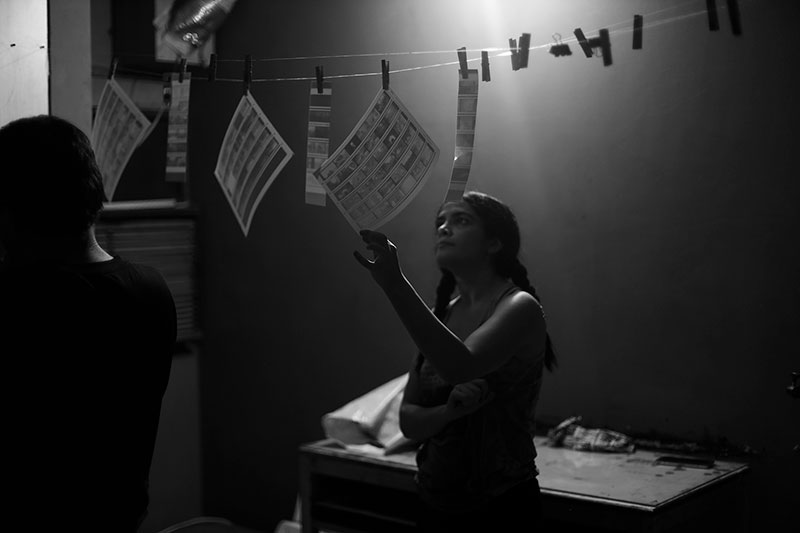
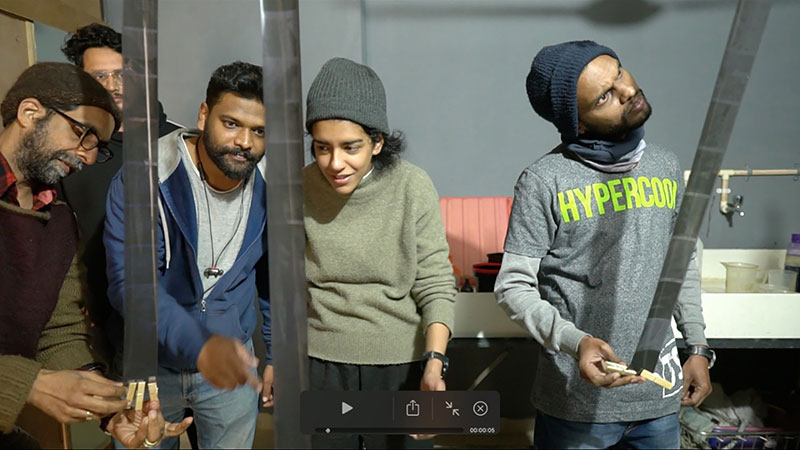 Photographs Courtesy of Maze Collective
Photographs Courtesy of Maze Collective
A major challenge for each such institution has been financial sustainability. In a country like India, where the State’s support for the Arts is extremely limited in view and scope,[4] institutions must rely on a handful of grants made available by the private sector; corporate sponsorships, patronage, and creating an earning model that can work in sync with the practice and the vision of the institution. Ashish said during the interview that it was a crazy idea when they decided to put all their money toward renovating the darkroom, in the middle of the pandemic when commercial work largely was brought to a pause, and they didn’t know how or from where their next funding would come. This is a big learning curve for institutions run by artists / photographers when they self-organize and have to employ a combination of strategies to create a sustainable model and an arduous journey of conflicts between vision and reality, earning and sustaining, community and individual interests. In my experience, it is in this conflict where much of the complexity of self-organizing gets solidified and takes shape. The conflict becomes a site to often investigate and negotiate the visions of an institution and future paths. This also redefines the nature of the ways in which one would define community, collaboration, and collective.
At a more practical level, learning to create sustainable models in the art / photography[5] world remains a mystery, since there isn’t a single-formula solution to the situation. It is a journey and a process of negotiating at multiple levels which includes learning about and adapting to the changing government policies on tax, company formations, and other legal know-how.[6] The arts / photography education system in the country requires updating on several levels. Indian arts / photography graduates are left to fend for themselves, learn from their own experiments of self-organization. While institutionalizing can become a way to sustain a practice, the space, and, if one is lucky, a way to earn a living, it surely takes years of patience and an immense investment of time, labor, emotional energy, money, and other resources.
It is one thing to build a community and entirely another to build an audience to engage with that community. One would imagine that the audience or the art appreciator exists out there, ready to consume the new product as it hits the market. This equation is often fraught for spaces such as these three since part of audience and community-building often entails an active participation in the making process, quite the opposite of looking at art on the wall or acquiring a piece from a gallery. In my conversation with Arpan and Shreya, it was evident that the struggle was to create their own audience to blur the boundaries between the maker and their viewer, creating a different dynamic for the community that emerges from maker’s spaces such as Studio Goppo and the others.
A common thread that emerged from my conversation with the three spaces was how all of them remain in conversation with each other, support each other, and are part of each other’s learnings while remaining independent entities. Cėline Condorelli in Too Close to See: Notes on Friendship, a Conversation with Johan Frederik Hartle talks about friendships “… as an essentially political relationship of allegiance and responsibility….” Here, I would like to explore how friendships become a form of affective labor for support and institution-building, as read by Condorelli. Her larger work on friendships, support structures, gender, philosophy, history, and the arts fills a large gap in the ways in which we understand support and friendships in the arts. Self-organizing by the artists is a story of friendships that forms a foundation and framework for both emotional and professional support. It was quite evident in these conversations how the three spaces in various degrees have come to rely on other spaces, collectives, and practices in ways that they have forged alliances and friendships that are enabling and supportive. While interviewing Ashish and Zahra, they extensively talked about how Arpan Mukerjee from Studio Goppo has been a mentor and a friend on whom they can always rely. A similar relationship exists between the Maze Collective and Srinivas Kuruganti from the Analogue Approach Project in Delhi – a relationship of friendship between the individuals and now two similar spaces in the same city. Kānike, though geographically far from both Studio Goppo and Maze Collective Studio, remains a close friend of both. In this network of friendship and community, all three spaces have been actively creating and sharing a knowledgebase of 19th century photography processes, sources, materials, and experimenting with the chemical recipes while accounting for Indian weather conditions. Since most of the books available on these processes were written by Western photographers in a very different time and geographical context, this information needs to be constantly reworked for the local context and the availability of resources today. This is just one example of the material manifestation of such relationships and yet not sufficiently evident of the ways in which these relationships run deep and far beyond the material scope and create alliances with many other communities. Thus, while there are limitations for monetary support, there is a possibility of abundance for other kinds of support, without which the practice of self-organizing would be a very isolating experience. In this discussion on friendships, the aim is not to create a positivist, essentialist, altruistic or a utopian idea of relationships and support systems. But to bring to light a complex terrain that forges new paths and associations for artists to self-organize and find resources in non-mainstream institutions and networks.
Other such collectives sharing a similar timeline are the Analogue Approach Project in Delhi and the Farside Collective in Leh. The Photo Company and Goa-CAP were perhaps the earliest iterations of similar organizing by photographers around analog photo technology. The history of photographers organizing themselves is a long, often under-documented story as old as the medium itself in India and outside. Alfred Stieglitz’s 291 is a classic example of photographers coming together to promote and share their vision of photography. One does not have to look so far though. Photography clubs across India, dating as early as the mid 19th century, are examples of photographers coming together for common interest, creating support systems to learn, exhibit, and unionize, as well establish dialogs with other such clubs to build a community across state borders. Of course, where the contemporary collectives are marked by their own cultural and artistic context, these historical threads offer us a glimpse into the ways in which photographers have self-organized through time. There are also other themes around which photographers collectivize today which have not been the focus of this essay. A few of these are worth mentioning here: Confluence Collective in Darjeeling-Sikkim focusing on narratives from the region; Her Pixel Story from Kashmir, a collective of women photographers with a two-fold vision of gender and photography from the valley; Eight-Thirty, a collective of nine women photographers, a peer network for intimate dialog on everything that is photography and outside of it; PEP Collective in south India, with a focus on environmental justice; Northeast Lightbox, a collaboration to explore the Northeast region with a multidisciplinary approach. A growing interest in photo books as a medium has given rise to independent publishing spaces and libraries, such as the Offset Projects and the Bind Collective. Reliable Copy, a publishing house based in Bangalore, has been working extensively with the photographic material even though their publications are not always focused on photography. Individual photographers / artists have created publication spaces for their own work and, though not a collective, these publications spaces have often created a space for public engagements – a few examples are: Editions Jojo, Mazi Books, and the Ugly Dog Books. Other collectives also have emerged around analog films and have been working actively with 16mm and super 8 formats. This is in no way an exhaustive list, but merely skimming the surface of a demographic of activities taking place in India within the last decade. These forms of self-organizing by photographers, though outside the circuit of the mainstream art world, remain in dialog with it.
Unlike other visual media, photography has always been seen and projected as a profession, a career for earning a living. Alison Byrnes in Gallery as Practice: Informal Art Spaces in North Bangalore says, “The relationship between art-making and money-making has always been fraught. The desire to make art, at least for the past hundred years, has been considered more of a calling, or vocation, rather than a career.” However, photography has always been a service industry since its invention. Photographers, though on the periphery of the art world, have always self-organized in the form of photo clubs, photo competitions, magazines, and other forms of publications. Amateur photography, as it is broadly termed, has its roots in forms of self-organizing and DIY practices as old as the medium itself and has played a major role in today’s visual culture. These contemporary practices of self-organizing that I focus on in the essay bridge the time past and the time future for it sits in an ecology of self-organizing and DIY practices that are defined by the predicaments of the medium as it goes through a radical transition. These forms of self-organization also become key sites of explorations as collectives and communities to differently exist in an art world.
__________
[1] The terms photographer and artist are used interchangeably due to the very blurry lines that separate the two categories of creative labour. Practitioners, often, like to be called one or the other or are okay with both. However, for the purposes of this essay, the terms are used in their contexts and are to be read in a porous manner.
[2] In the Indian context, today, ‘non-profit’ is a complex term entangled in the web of policies by the current right-wing Government and a position almost impossible to hold for most contemporary institutions. This political positioning of ‘non-profit’ in India needs to be discussed in greater detail, however, not within the scope of this essay. Suffice to say that the reading of ‘non-profit’ in the Indian context goes beyond the dualistic nature of the term that Karlsen suggests.
[3] Kānike’s extensive public programming not only centered around photography but also around other forms of art brings together many communities. The zine festival they conducted in the beginning of 2022 included zines of more than seventy artists from all over India. The space regularly hosts musical events, workshops, exhibitions and has kept their doors open to anyone interested in learning about photo processes.
[4] The Ministry of Culture does allocate a dedicated fund every year for the entire arts and culture industry. However, the young practices of experimentation and explorations are quite outside the State’s expectations from the arts. These new self-organizers have little to no hope of any government support. According to the Sahapedia budget guide of the Union Budget 2021-22, it is clear that there is a gradual decline in the budget allocations for the arts. Crafts and folk arts sector, largely supported by the Ministry of Culture, is hit with these budget cuts. Combination of the declining Government support and the impact of pandemic has put many practices within these sectors at risk of extinction. When the State supported and recognised arts activities are seeing such hardships, young art’s organizers probably do not stand much of a chance.
[5] This does not include commercial ventures and privately funded institutions such as galleries.
[6] For Zahra from the Maze Collective, the struggle with bureaucracy is also a struggle of State border restrictions, visa extensions and ever changing Government policies around it.
Copyright © 2023, PhotoSouthAsia. All Rights Reserved.
Chinar Shah is an artist based in Bangalore. She is the founder of Home Sweet Home, an exhibition series that uses domestic spaces to show works of art. She has received grants from the Inlaks Shivdasani Foundation, Pronto - Göteborg Stad Kultur of the city of Gothenburg and AHRC, UK. She is an artist in a UKRI grant under their Global Challenge Research Fund, 2019. Chinar taught photography and visual arts at the Srishti Institute for Art, Design and Technology, Bangalore, and is the co-editor of Photography in India: From Archives to Contemporary Practice (Bloomsbury, UK, 2018).
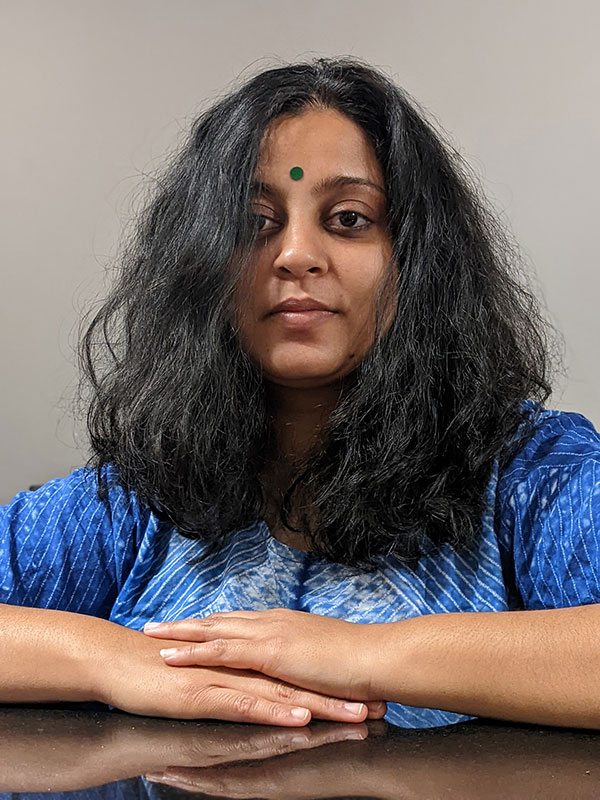 Copyright © Chinar Shah
Copyright © Chinar Shah
Reimagining Flowers in Photography
Question of Photography, 2020
A Visual Journey: The Death of Vivek Oji by Akwaeke Emezi
Photography in India from Archives to Contemporary Practice, ed. with Aileen Blaney, Bloomsbury Visual Arts, Bloomsbury Publishing, London, 2018
20 November